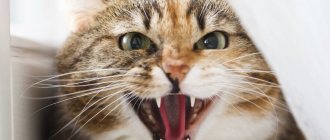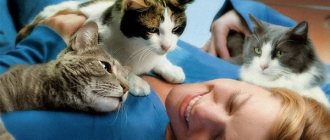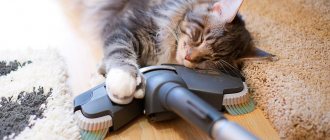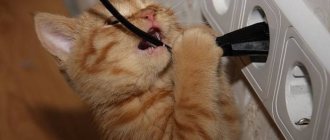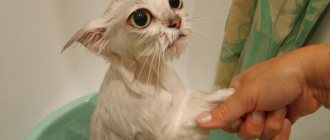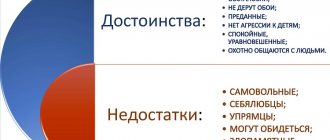A cat is in heat: how to cope
It would seem that getting a cat, not a cat, is the best solution. After all, there are fewer problems with her: she doesn’t ask to go outside, she doesn’t mark corners. The main misconception that an owner may encounter when choosing a cat for himself. And if you still intend to get a cat, you should prepare from the very first days for the fact that at a certain age she will go into heat. This is a natural process in the animal’s body, however, you need to prepare for it in advance. In this article, we told you what to do if your cat is walking, how to calm it down at home, what medications and folk remedies are suitable. You will also learn what methods of calming without drugs are available.
At what age do cats start “walking”?
As a rule, the first heat in cats begins at 6-11 months of age. It is difficult to give more precise dates, because it depends on many factors:
- season - the first heat begins closer to spring;
March cats are no joke. Increasing the duration of daylight hours encourages the onset of estrus. If the cat is six months old in the spring, you should expect the onset of estrus soon. If the same age falls in October-December, then the onset of estrus is more likely only next spring.
- Heredity;
In mixed breeds, the onset of the first heat is difficult to predict in advance, but among purebreds, patterns have already been identified.
The fastest maturing are the short-haired “oriental” breeds - Thai, Siamese, Burmese, Abyssinians, Bengals, Cornish Rex. On the other hand, cats of long-haired breeds sometimes begin to walk at 10-12 months and later - Persian, Maine Coon, Siberian.
Bengal cat. The first heat occurs at the age of 5-6 months.
- Type of temperament;
Some cats are more temperamental than others, and some, on the contrary, are late maturing.
- Physical condition;
In weakened individuals suffering from chronic diseases, this period begins later. Exhausted cats lacking vitamins and fats do not go into heat.
- Interactions with other individuals;
The presence of another cat in heat or an unneutered cat provokes the onset of heat in young teenage cats.
The maturation cycle of a cat during estrus:
Veterinarians divide this period into 4 phases:
Proestrus (precursor). Lasts 1-4 days. At this time, the hormonal background changes, and the first deviations in the animal’s behavior appear. The cat begins to cuddle, constantly asks for attention from the owner, rubs herself, rolls on the floor, but does not yet allow cats to come near her.
Estrus. Lasts 1-1.5 weeks. This is the peak of hormonal activity when slight clear discharge appears. The animal becomes uncontrollable: constantly meows loudly, arches strongly while stroking. She presses her chest to the floor, and puts her back up, as if inviting the male to mate.
Metestrus (after-leak). Lasts 2-19 days. If the cat manages to mate, pregnancy already occurs during this period (sometimes it can be false). Interest in males at this time gives way to pronounced aggression.
Anestrus (interestrus). The cat calms down completely. Behavioral signs of sexual activity disappear. Appetite and daily routine return to normal.
If during a period of high hormonal activity the cat failed to mate and, accordingly, there was no pregnancy, after some time the estrus repeats.
A cat's heat period
It will be impossible not to notice that the cat is in heat. Each owner can easily determine the moment when a cat starts estrus:
- Loud scream and purring of a cat.
- The appearance of marks throughout the home, which the cat makes during estrus, when she begins to have copious discharge.
- While the cat is walking, she stands in certain positions, which indicates a desire to mate with the cat. So, she begins to lower herself onto her front paws, while her croup will be raised and her tail will be moved to the side.
- Poor appetite. The animal may not eat well or completely lose its appetite.
- Frequent urination, uncharacteristic of the usual condition.
- Excessive affection. She will constantly curl around her owner's feet, the legs of tables, chairs and other objects, and purr loudly. There are times when an animal expresses its desire through aggression.
If these signs are present, we can confidently say that the cat wants a cat.
Features of the mating season in cats
Jokes about March cats are common in folklore. In fact, the desire to continue the race can overtake representatives of the cat family in any month. What is noteworthy is that the regularity of such hormonal surges is individual for each animal. The only thing the owner doesn’t have to worry about is that he won’t be able to miss the mating season. During a hormonal surge, cats scream or meow pitifully, some animals can become aggressive, others, on the contrary, require attention and affection from the owner. Another unpleasant manifestation of the basic instinct is the desire to mark territory. Even the most obedient animals can begin to “leave their mark” throughout the apartment. Agree, all this is not very pleasant. We will try to list all the most effective and safe ways to calm a cat during the mating season.
How often does heat occur?
This period occurs 3-4 times a year. The most common option for a cat that has already bred at least once is a constant estrus once every 3 months. However, if the cat has not yet walked, then your pet may be bothered by frequent estrus: monthly or even once every 2 weeks. If the heat has passed and your pet has not taken a walk, after 2-3 weeks everything can happen again.
If your cat has stopped estrus for a long time (more than a year) or, conversely, has a long, protracted estrus (more than 15 days), this is a serious problem and you should contact your veterinarian.
How quickly does heat return after giving birth?
About 64 days pass from the date of first mating to birth. Then the cat feeds the kittens; the duration of this period largely depends on the owners. 10-14 days after the end of lactation, estrus resumes.
But some lactating cats go into heat as early as two weeks after giving birth. If mating with the cat does not occur at this moment, then the cat begins to walk, as before, every 10-20 days.
Pregnant cat
Treatment with hormonal drugs
The heavy artillery in the fight against basic instinct is hormonal drugs. Such medications can be purchased at a pet pharmacy without a prescription or at a veterinary clinic. It is advisable to consult a doctor before consuming such serious drugs. Hormonal drugs are quite dangerous, and if taken regularly, the risks of developing chronic diseases increase. Many experts say that drugs in this category are not the best way to solve the problem of how to calm a cat. The thing is that hormonal pills and drops do not always act effectively and quickly. An alternative option is injections. Injections will definitely silence the cat, but at the same time they are even more dangerous for the pet’s health. It is worth noting that the cost of injections is quite high.
Medicines
Spring, time for love. This is where the sleepless nights of cat owners begin. Exhausted owners, tired of the cat’s constant, heart-rending screams, are looking for ways to calm the animal. What to do if your domestic cat goes on a spree?
The first thing that comes to mind is to calm the pet in a natural way and call the cat for help.
But, if you still don’t need offspring, and you need to calm the cat down, medications will help you. Before giving your pet medications, it is best to consult your veterinarian. Since each cat may have various contraindications.
Giving pills, giving injections or buying drops if the cat starts to go on a spree is a temporary measure that is under no circumstances recommended to be used on an ongoing basis.
There are two types of medications for cats during estrus:
- Hormonal. They can interrupt estrus, or significantly reduce its active phase and even delay the onset. Hormones are also used in case of unwanted pregnancy. They may well rip it off.
Among the hormonal drugs, the most famous are:
- Contra-Sex
- Sex barrier
- Cowinan
- Stop-Intimate.
They come in the form of injections, tablets, and suspensions. It cannot be used independently or systematically.
Hormonal agents
With the constant use of hormones, 70% of animals endure forced sterilization for medical reasons. It is much safer to deprive your pet of reproductive function soon after puberty.
- Sedatives. They do not affect estrus, they only correct behavior. With their help, you can quickly achieve inhibition of reactions and calm the nervous system. Often prepared from herbs.
- Kot-Bayun (extracts from plant materials: herbs oregano, sweet clover, motherwort, St. John's wort, ivy bud, catnip, thyme, marshweed, hill solyanka and lemon balm, rhizomes with valerian roots, hawthorn, hop cones, peppermint leaves);
- FITEX (valerian officinalis extract, motherwort extract, common hop extract, Baikal skullcap extract, glycerin and water);
- Stop stress (phenibut, complex of medicinal plant extracts: valerian rhizomes, catnip, motherwort, hops, Baikal skullcap).
Sedatives
Let your pet love
Owners of purebred animals usually look forward to the moment when their pet is ready to continue the family. If you wish, you can even look for candidates for the cat’s bride in advance, if he has a good pedigree. You can try to offer your cat as a groom to one of the cat owners you know, if he doesn’t have a breed, but is also handsome. And yet this is not a solution to the problem, but only a way to survive one of the pet’s mating periods. Some cat owners prefer to train their pet to “love” something inanimate. Try offering your tailed don Juan a soft toy or his bedding. However, this method of correcting sexual activity also has disadvantages. Don’t be surprised if, after a toy approved for “love,” the pet “loves” the owner’s fur coat or a soft sofa. But what to do if the cat goes on a spree, how to calm the pet?
Traditional methods of calming down during estrus
A cat is walking: how to calm it down at home? If you still don’t have any medicines at home, another way to calm the cat will help - traditional medicine.
Methods to help cope with “cat walking”:
- When the cat begins to have another attack of strong screaming, you can dip its butt in cool water and hold it in it for several minutes. Albeit not for long, but this measure will help calm down the wandering murka. You can do this every time the cat starts screaming loudly.
- To distract your cat from her heat, you can apply a small amount of butter to her face. As with the shower, the animal will be busy cleaning itself up for a long time afterward.
Behavior during estrus
- If a cat keeps you awake all night with its heart-rending screams, it is recommended that you forcefully pour 50 g of vodka into its mouth in the evening. An intoxicated and calm animal will sleep all night.
- For a day, a walking animal will be calmed by this recipe - crush ¼ tablet of Diphenhydramine and a whole tablet of valerian, mix the powders together and give to the cat. You can add a mixture of crushed drugs to food.
- Give your pet a decoction based on medicinal herbs that have a sedative effect. To prepare a decoction, you can use chamomile, mint or linden.
- A weak solution of vinegar is an effective, proven way to calm a walking cat to rest for a while. Dilute the vinegar with water to make a slightly sour-tasting liquid, and pour a small amount into the animal’s mouth.
What to do if the cat goes on a spree? Let go!
Thanks to the prohibitive amount of hormones in the blood, cats become real alpha males during the breeding season. Why do animals scream? This is both a call for relatives and an expression of overwhelming emotions. How to calm a cat so that he does not yell, on his own? Many owners of tailed pets suggest simply letting animals go for walks, so eager for freedom and adventure. In general, this is a good option if you live in a private house and the cat goes hunting from time to time. But we must not forget that the animal may simply not return home. Even in a quiet rural area, a domestic cat can be harmed by a wild animal or vehicle. In cities there are many times more dangers. It is completely unacceptable to throw an animal onto the street that has never been there before. This is a huge stress for your pet.
How to calm a cat without drugs
The best solution is to distract your pet with music, toys, crumpled newspaper (anything that rustles or rattles will do), pay more attention to her, and also change her diet. Let's look at each method.
Music therapy
Classics (Mozart, Bach, Beethoven, etc.) are suitable as a sedative. The sound of a piano or violin has a beneficial effect on the animal's nervous system.
Changing your diet
During the entire period of estrus, you need to control your diet - if the cat refuses to eat, you cannot force feed it. Food should be served in small portions, the menu should be varied and healthy. In order to somehow interest the cat and at the same time distract her from the torment of estrus, you can pamper her with various delicacies and goodies.
Insulation
There are cases when the proximity of people only aggravates all the problems that exist during estrus. Then it would be advisable to temporarily isolate the pet in a separate room, where it will be left to its own devices.
Isolating a cat in a dark room without access to daylight leads to the production of melatonin, which will lead to the cessation of estrus.
Are homemade sedatives safe?
Everyone knows about the attraction of cats to valerian. Sometimes this particular remedy is recommended as a sedative for our tailed friends. If you let your cat smell valerian or even lick some, its behavior will really change and become calmer. Still, this is not the best way to calm a cat when he is angry. Valerian is a safe sedative for humans. For cats, this is a real drug that is addictive from the first try. Giving valerian to tailed animals is not recommended. What about catnip? In fact, this remedy acts on the cat’s body in the same way as valerian, but somewhat weaker. This means that mint is also not very suitable for correcting the behavior of an animal during the mating season.
Mixing with a cat
The first mating is carried out on the third menstruation, when the pet has reached physiological maturity. This reduces the risk of miscarriages, infertility and other complications.
Before meeting her partner, the “bride” is vaccinated and dewormed. Her nails are trimmed and a set of personal items is collected that she will need while away from home. Mating is carried out on the male's territory to reduce his excitement.
The animals are left alone for several days to repeat cages many times. This consolidates the result, increasing the chances of successful fertilization. Help from the owners is required only in cases of aggressive behavior, discrepancies in the size of the partners, and the cat falling on its side.
Mating of purebred cats
If you are breeding purebred cats, you need to know exactly the time and period of mating. For example, the period of puberty in the British and exotic folds begins in the period from 7 to 9 months. If mating is carried out earlier, pregnancy for a cat can result in many complications.
British mating
Can a pregnant pet ask for a cat?
But providing a male is not at all recommended if the pregnant cat has gone on a spree. During this period, it is necessary to exclude any meetings with the cat, as this can cause irreparable harm to the offspring. In most cases, when a pregnant cat is again impregnated by a cat, then the first offspring is born, and the second dies.
But this doesn't always happen. Of course, disorders can occur in which a hormonal imbalance occurs, and the fruits can dissolve or a lot of different deviations and troubles can occur.
Therefore, a spreeful mug must be calmed down with the help of some home remedy or medication.
At such a moment, you need to lock your pregnant cat at home and give her a little more attention than usual. And you can be sure that after a while everything will return to normal, and she will live her usual life and will not want a cat and cause problems for her owner.
© shutterstock
Continuing the cat family and being able to see and play with these little bundles is a wonderful and commendable decision. But still, do not forget that not always when a cat demands a cat, she needs to be given one. Frequent pregnancy also harms the body . If you do not allow him to recover normally and rest after pregnancy, then babies with various disabilities may be born. However, it is imperative to help a cat that has gone on a spree.
Does a cat walk after sterilization?
The most radical and effective way to calm a cat is to sterilize it. Doctors recommend that the procedure be carried out as early as possible for the health of the pet. A cat at a young age tolerates anesthesia more easily. The recovery period is short - within a few weeks you will forget about a trip to the veterinary clinic.
There are two types of operations:
- Sterilization. It involves limiting reproductive functions by simply ligating the fallopian tubes. It is important to understand that the ovaries remain in place and continue to produce hormones. This means that the cat will come into heat at a natural time. The symptoms will be the same as before the operation. The only plus is that she will no longer bring kittens.
- Castration. As a result, the animal is left without reproductive organs. It can be partial, when only the ovaries are cut out, and complete, when the uterus is also deprived. The latter option guarantees the absence of possible complications in the future. In general, this is the surest calming method for cats.
The main advantage of the operation is a 100% guarantee of no relapse. If you decide to castrate, you can be sure that your cat will never lose her head in love again in her life.
Cat after sterilization
Tablets for calming the pet and owner
Any pet store or veterinary pharmacy has an impressive range of special medications for “cat love”. Drugs of this type are divided into two categories: sedatives and hormonal. The first ones are safer. They do not affect hormonal levels, but at the same time stabilize the functioning of the central nervous system. If you care about the health of your animal, choose products based on natural plant extracts. For ease of use, you can find medications on sale in various forms: drops, tablets, granules for adding to food.

